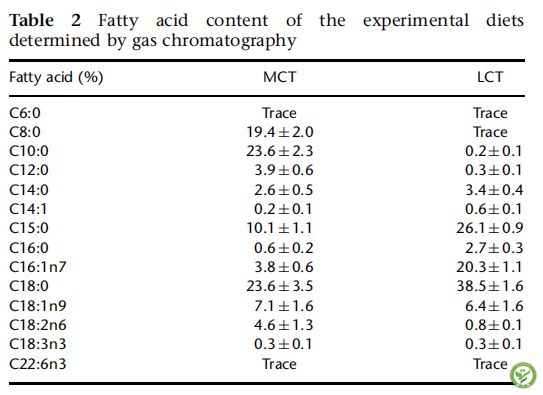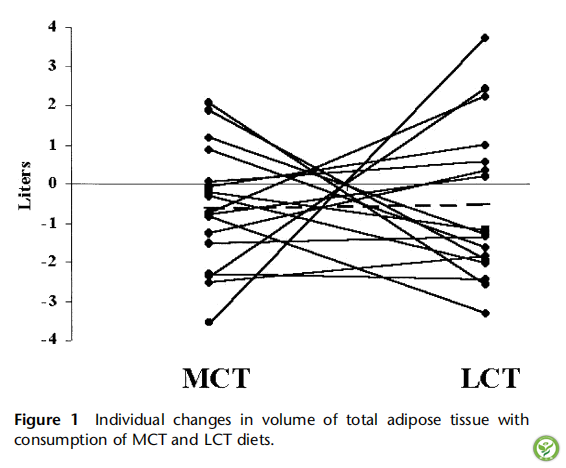Medium-versus long-chain triglycerides for 27 days increases fat oxidation and energy expenditure without resulting in changes in body composition in overweight women
作者:M-P St-Onge1, C Bourque, PJH Jones, R Ross and WE Parsons
来源:International Journal of Obesity (2003) 27, 95–102. doi:10.1038/sj.ijo.08032169
翻译:肠动力研究院 梁琦
【实验目的】:测定长期食用中链脂肪酸甘油酯(MCT)和长链脂肪酸甘油酯(LCT)对能量消耗(EE),底物氧化,和机体著称的影响。
【实验假设】:与长链脂肪酸甘油酯相比,食用中链脂肪酸甘油酯并不能导致机体大量能量消耗、底物氧化和体重减轻。
【研究方法和实验流程】:17名健康的肥胖女性参与了这项随机的交叉住院试验。每顿饭都在现场准备和食用,2个阶段共为期27天。食物中能量40%为脂肪,其中对照组含有75%,总脂肪,旨在为每个受试者提供各自维持体重的能量需求。MCT食物中替换对照组67%的脂肪为MCT油(49%为辛酸,50%为葵酸),而LCT食物中只含有牛油。在每个阶段的第1天和第28天通过核磁共振成像(MRI)评估机体组成,而在第2天和第27天测量机体能量消耗。
【实验结果】:根据不同组别MCT和LCT的摄入来看,受试者的总脂肪变化和皮下脂肪组织体积差异不显著(-0.61±0.38 lvs 70.54±0.48和0.58±0.35 lvs 70.48±0.40)。与LCT相比,食用MCT的能量平均消耗和脂肪氧化值差异显著(P < 0.05),(对于能量消耗,0.95±0.019 vs 0.90±0.024 kcal/min;对脂肪氧化,0.080±0.0026 vs 0.075±0.0022g/min,)。
【结果分析】:研究结果表明:与LCT相比,长期食用MCT可提高肥胖女性的能量消耗和脂肪氧化。尽管没有统计学差异,在MCT组和LCT组之间,受试者身体组成变化的差异与能量消耗的预测变化的差异相一致。该研究能够得出以下结论:在能量平衡的食物中使用MCT代替LCT可能通过能量消耗的方式来防止长期机体增重。
关键词:中链脂肪酸甘油酯;机体组成;核磁共振成像;能量消耗
以下是实验中的相关图表
表1:受试者机体特征

表2:气相色谱法测定实验食物中的脂肪酸含量

图1:食用MCT和LCT的个体总脂肪组织的体积变化。

图2:食用MCT和LCT的个体皮下脂肪组织的体积变化。

图3:食用含有MCT或LCT的早餐后第2天(A)和第27天(B)的能量消耗。实心方块=MCT阶段;空心方块=LCT阶段。数值=真实值±SEM,n=17。MCT显著不同于LCT(P < 0.05)

图4:食用含有MCT或LCT的早餐后第2天(A)和第27天(B)的脂肪氧化量,实心方块=MCT阶段;空心方块=LCT阶段。数值=真实值±SEM,n=17。MCT显著不同于LCT(P < 0.05)

图5:计算受试者食用含有MCT或LCT的食物27天所消耗的能量。

启示
总的来说,在健康的超重女性中,与LCT相比,MCT的摄入提高了能量的消耗和脂肪氧化。此外,在食用富含MCT的27天,能量的消耗和脂肪氧化的水平持续升高,但与身体脂肪组织的沉积无关。尽管不能得出这样的结论:与LCT相比,长期食用MCT会导致体重更大幅度的减轻,但MCT的摄入会使得能量消耗和脂肪氧化增加。这可能会有助于肥胖女性长期维持体重。
Abstract
OBJECTIVE: To determine the effects of long-term consumption of medium chain (MCT) versus long chain triglycerides (LCT) on energy expenditure (EE), substrate oxidation and body composition
.
HYPOTHESIS: MCT consumption will not result in greater EE, substrate oxidation, and body weight loss compared with LCT consumption.
RESEARCH METHODS AND PROCEDURES: Seventeen healthy obese women participated in this randomized, crossover inpatient trial. Meals were prepared and consumed on site for two periods of 27 days. Diets containing 40% of energy as fat, with treatment fat comprising 75% of the total fat, were designed to supply each subject with their individual weight-maintaining energy needs. The MCT diet contained 67% of treatment fat as MCT oil (49% octanoate, 50% decanoate) whereas the LCT diet contained exclusively beef tallow as treatment fat. Body composition was assessed by magnetic resonance imaging (MRI) on day 1 and 28 of each phase while energy expenditure was measured on day 2 and 27.
RESULTS: Changes in total and subcutaneous adipose tissue volumes following consumption of MCT and LCT were not different(-0.61±0.38l vs -0.54 0.48l and -0.58±0.35l vs -0.48±0.40l, respectively). Average EE and fat oxidation were greater(P<0.05) during MCT than LCT consumption (0.95±0.019 vs 0.90±0.024 kcal/min, respectively, for EE and 0.080±0.0026 vs 0.075±0.0022 g/min, respectively for fat oxidation).
DISCUSSION: These results show that long-term consumption of MCT enhances EE and fat oxidation in obese women, when compared to LCT consumption. The difference in body composition change between MCT and LCT consumption, although not statistically different, was consistent with differences predicted by the shifts in EE. It can be concluded that substitution of MCT for LCT in a targeted energy balance diet may prevent long-term weight gain via increased EE
Keywords: medium chain triglycerides; body composition; magnetic resonance imaging; energy expenditure
Implications
In conclusion, present results show that EE and fat oxidation are increased with MCT consumption compared to LCT consumption in healthy overweight women. Furthermore, raised levels of EE and fat oxidation remained consistently elevated during 27 days of consumption of a diet rich in MCT but were not associated with a detectable difference in effect on body fat depot size. Although it cannot be concluded that prolonged MCT consumption results in greater weight loss compared to LCT consumption, MCT intake resulted in increased EE and fat oxidation. This may promote long term weight maintenance in obese women.
如您需原文,请联系本文作者和出版方,或请垂询肠动力研究院。本网站发布的所有资料将尽最大可能注明出处、作者及日期,如无意中侵犯了您的知识产权,请来信及时告知,我们将立即予以删除。
All information released by the WeChat Official Account will do its best to indicate the source, author and date. If we inadvertently infringe on your intellectual property, please inform us in time and we will delete it immediately.






